Head and Neck Injury
Moderate to Severe Head and Neck Injuries
Moderate to severe head and neck injuries require emergent care to prevent spinal cord damage and possible paralysis.
What is a Head Injury?
A head injury is any trauma to the scalp, skull or brain. Injuries may range from a bump on the head to a traumatic brain injury. Head injuries may be closed or open. Closed head injuries are often the result of a hard blow to the head from striking an object, but the object did not break the skull. An open (or penetrating) head injury is often the result of an object hitting your head and breaking your skull and entering the brain. Open head injuries may occur as a result of a car accident or gunshot to the head.

What Are the Different Types of Head Injuries?
Head injuries may include concussions, scalp wounds and skull fractures. Concussions are the most common type of traumatic brain injury with 1 in 6 injury-related hospital admissions every year.
What are Symptoms of a Serious Head Injury?
Serious head injuries require emergency medical treatment. Symptoms include:
-
Convulsions
-
Confusion
-
Loss of consciousness
-
Distorted facial features
-
Slurred speech
-
Severe headache
-
Vomiting
-
Low breathing rate
-
Memory loss
The more serious head injuries can cause bleeding in the brain tissue or in the layers that surround the brain (i.e., subarachnoid hemorrhage, subdural hematoma, extradural hematoma), and therefore require emergency care.

What Are the Most Common Causes of Head Injuries?
The most common causes of traumatic head and skull injuries include:
-
Falls
-
Accidents at home, work, outdoors or while playing sports
-
Physical assault
-
Traffic accidents
How Do You Know if You Have a Serious Head Injury?
Victims of a serious head injury often have severe head and face bleeding, and they may be confused, tired or unconscious. Others might experience short term memory loss (amnesia), headache, vomiting or a seizure.
How Is a Head Injury Treated?
The treatment of a traumatic head injury depends on the type of injury. At The Emergency Center, the doctor will order a cranial CT (computerized tomography) scan to see if there is swelling or bleeding in the brain or a fracture in the skull. If you were to have complications after a concussion, the doctor may order a MRI (magnetic resonance imaging) to help diagnose those complications.
Whatever the outcome, your doctor will discuss treatment options with you with the goal of returning you to the level of function you had prior to the traumatic injury.
What Is a Neck Injury?
A neck injury is any damage to the neck including soft tissue, bone, spinal column and nerves.
Should You Move a Patient with A Neck Injury?
DO NOT MOVE PATIENTS WITH NECK INJURIES UNLESS THEY ARE IN HARM’S WAY. This is also good advice for patients with head injuries, as head injuries are often associated with neck injuries. In either case, wait for trained medical personnel to help with moving the patient.
What are The Different Types of Neck Injuries?
The most common neck injuries include a crick in the neck, a muscle strain, a neck sprain, whiplash, a herniated disc, a neck fracture (break in a cervical bone), a cervical dislocation, stingers and burners (temporary injuries to the nerve root or brachial plexus), and a spinal cord injury.
The first three listed are soft tissue injuries that can be mild, moderate, or severe and are graded, meaning they range from mild to severe. The most severe cases may require emergent medical treatment due to pain or risk of fracture or vertebral dislocation.
What are some common causes of neck injuries?
The most common causes of neck injuries include:
-
Motor vehicle accidents
-
Falls
-
Acts of violence
-
Sports and recreational injuries
-
Alcohol
-
Diseases
What Are the Symptoms of a Neck Injury?
Neck injuries can lead to spinal cord injury and permanent disability. Symptoms of a neck injury often include:
-
Extreme back pain or pressure in your neck, head or back
-
Weakness, incoordination or paralysis in any part of your body
-
Numbness, tingling or loss of sensation in your hands, fingers, feet or toes
-
Loss of bladder or bowel control
-
Difficulty with balance and walking
-
Impaired breathing after injury
-
Oddly positioned or twisted neck or back
What Can You Do to Help?
There are several things you can do to help someone with a traumatic neck or back injury while waiting for emergency care to arrive, including:
-
Don’t move the injured person, which could cause spinal cord damage
-
Do not try to straighten the neck
-
Do not remove a helmet
-
Call 911 or your local emergency assistance number
-
Keep the Person Still
-
Place Thick Towels on Both Sides of the Neck or Hold the Head and Neck
-
Provide basic first aid
-
Stop any bleeding
-
Make the person comfortable
How is a Neck Injury Treated?
Serious neck injuries require immediate medical attention, as they can lead to serious spinal damage or fatal complications, including paralysis. When you come to The Emergency Center, the doctor will quickly provide treatment with personal care and make a plan for your recovery.
FAQs About Head and Neck Injury
What are the risks of neglecting a neck injury?
If a neck injury goes untreated, it can lead to severe complications, including permanent nerve damage, spinal cord injury, and even paralysis. The injury may worsen over time, causing chronic pain, loss of mobility, and impaired function. Early treatment is crucial to prevent long-term damage and ensure proper recovery.
How quickly can a brain bleed occur after a head injury?
A brain bleed from a head injury can develop within minutes to days after the trauma. Symptoms such as confusion, severe headache, vomiting, or loss of consciousness could indicate a brain bleed. It’s crucial to seek immediate medical attention, as delays in treatment can lead to severe complications and worsen the condition.
When can a bump on the head be worse than a concussion?
A bump on the head can sometimes be more serious than a concussion, especially if it results in a more severe brain injury, such as a brain bleed or skull fracture. If the bump causes symptoms like loss of consciousness, severe headache, nausea, vomiting, confusion, or weakness in limbs, these may be signs of a more serious injury. A concussion is a type of mild traumatic brain injury, but complications can arise if not properly monitored or treated. Immediate medical attention is essential if any of these signs appear to ensure proper diagnosis and care.
What are the symptoms of a cervical spine injury following a neck injury?
A cervical spine injury can lead to symptoms such as severe neck pain, difficulty moving the neck, numbness or tingling in the arms or legs, weakness, or loss of coordination. In more serious cases, there may be trouble breathing or loss of bladder control. If any of these symptoms occur after a neck injury, it is crucial to seek immediate medical care to prevent permanent damage.
Can a concussion be diagnosed without an MRI or CT scan?
Yes, a concussion can typically be diagnosed based on symptoms and a physical examination by a healthcare professional. However, if there are concerns about more serious brain injuries or complications, imaging tests like an MRI or CT scan may be recommended to rule out other issues.
https://medlineplus.gov/ency/article/000028.htm
https://www.mayoclinic.org/diseases-conditions/spinal-cord-injury/symptoms-causes/syc-20377890
https://www.verywellhealth.com/most-common-neck-injuries-described-296664
What Our Patients are Saying About Us
My visit to the emergency center of San Antonio was amazing. I was seen right away for sciatica pain. Dr. Styskal was amazing. I was treated right away and sent home with my medication. I wish more facilities would practice this without you having to make an additional stop at a pharmacy for medication. I know five stars is the highest I can give but they deserve 100+ stars.
Lizette M. ★★★★★
I was skeptical about going to the Emergency room, because for me ER’s have a bad reputation. My experience here was one of the best experience I’ve ever had. Keith at the front desk was very nice and went above and beyond for me. I forget my insurance card and wanted to know how much my co pay would be. He looked me up with no issue, brought my a wheelchair to ease my pain, as well as started
Mecia T. ★★★★★
My first time coming here, was greeted immediately by Keith and Debbie and helped. When in the back, Nichole wasted no time getting my vitals, checking on how I was feeling, and was super friendly and comforting while doing so. Dr. Erdner was very nice, and informative. Johnny got my CT scan quickly and made the process easy, and fast. All together the staff made my visit a great experience.
Nicole D. ★★★★★
Get Directions To Visit Us
Alamo Ranch
Conroe



